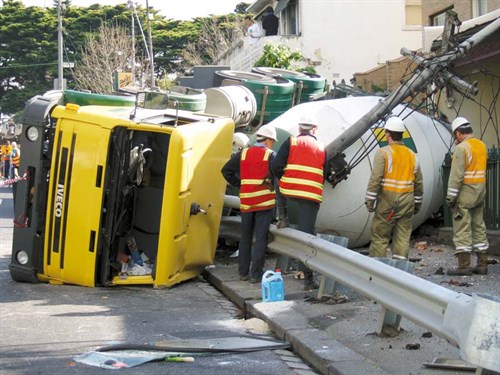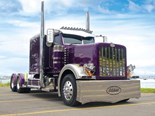Why trucks roll over





|

|
The NZ Transport Agency and Road Transport Forum are spearheading a programme to reduce the amount of truck rollovers. The Ed went along to a seminar to find out more.
Unless you’ve been living under a rock, it seems that a week doesn’t go by without some news of a truck rollover somewhere around the country. Over the recent past it seems that a disproportionate number of incident reports stem from the Northland area, however the rest of the country is certainly not immune to this phenomena.
It did seem fitting though that the initiative to educate drivers about why their trucks roll over started at the top of the country and now four weeks (and 28 sessions) later it is being presented to a group of around 25 drivers along with a couple of hangers-on like myself at the NZ Trucking Association headquarters in Christchurch.
With another 22 sessions to go before facilitator Jeff Fleury hits the target of 50 presentations, it’s pretty obvious that he’s now well settled into the routine, as he introduces himself and backgrounds the seminars, their purpose, and how they came about in the first place.
Having past occupations as a motor mechanic and inspector with the CVIU (Commercial Vehicles Inspection Unit), based in the lower part of the South Island; the qualifications and work experience make Fleury well qualified to impart his knowledge, which he does in a clear, no-nonsense manner that engages the audience in what he describes at times as a ‘mum and dad talk’.
Why trucks roll over
Along with a number of images from actual incidents, Fleury says that there is one main reason why a truck rolls over – speed into a corner. While that answer is pretty obvious to most of us, there are a large number of factors that contribute to a rollover which is the reason why the group has gathered on a cold winter’s night for a couple of hours; to find out more about the technical details, this being primarily done by returning to some basic high school physics.
To keep a rig’s stability as it negotiates a bend in the road, some key factors are: speed, centre of gravity, track width, suspension, and tyres. Also thrown into the mix for good measure are the types of vehicle combinations, which in New Zealand and Australia are different to many parts of the world.
"Additionally, there are more hills, bridges, corners and fewer divided highways per 100 kilometres of roadway than most developed countries, so professional drivers have really got their work cut out for them," says Fleury.
Centre of gravity
The laws of nature are what conspire to keep a vehicle on a road – or off a road as the case may be. Foremost to this is understanding a bit about the centre of gravity, which is critical to staying on the tarmac. Obviously, the higher the centre of gravity, the more likely a vehicle is to overturn.
Fleury’s demonstration is cleverly done by comparing a truck’s trailer to that of a yacht and it’s plain to see that the trailer’s deck is like yacht without a keel – and therefore pretty easy to roll on its side if all the weight is sitting above the ‘water’. Trailers have very little weight below the ‘waterline’, whereas a truck can be a bit more difficult to put on its side as there is the engine, gearbox, and diffs to provide a greater degree of stability – or act as a keel, one could say.

"Generally, the trailer will go first and this will take the truck with it," says Fleury.
Speaking to some of the truckies during a break, a couple are of the opinion that the numerous comforts in trucks these days contribute to the amount of rollovers as they delay a driver’s reaction time.
"By the time the air suspension transfers what’s happening through the truck to the air-ride seat, the truck is already gone," quips one driver, while another suggests that he never had a TK Bedford roll over on him as he felt every bump and curve on the road.
Turning and centrifugal force
Other contributors to truck rollovers that Fleury speaks about are the turning force and centrifugal force; the former is induced by the driver as they turn the steering wheel, and the latter slides your packet of Burger Rings across the dash and out of reach. The way that the turning force is handled by the driver makes a truck more or less stable and as we have all learnt from past experience, driving through a corner too fast creates excess centrifugal force, which causes the vehicle’s weight to move to the outside of a turn.
Certificate of Loading
A report by NZTA says that 15 percent of vehicles with a SRT (or Static Roll Threshold as it is correctly called) of less than 0.35g were involved in 40 percent of rollover crashes and Fleury makes no apology for the CVIU pulling a vehicle off the road if the load on board exceeds its Certificate of Loading.
Importantly, these labels refer to a SRT and it is imperative that anyone who calls themself a professional driver understands what these important labels on their rigs mean as they tell how much weight can be carried and how high it can be stacked. It also tells a driver how many ‘Gs’ the vehicle will withstand before it will roll.
Keeping it 10 below
While these numbers and acronyms can sound a bit daunting to a lot of people, Fleury says that there is one very easy way to ensure a driver keeps their rig upright when cornering.
"If drivers keep it 10km/h below the recommended advisory signs on corners, they’ll be upright when they exit the corner."
He’s not just saying this off the cuff though. Roadside advisory signs are calculated with a recommended speed that reflects a maximum of 0.22g of sideways acceleration following a constant, steady path at the posted speed through the corner. So, if you keep it 10 below the posted speed, then chances are you’ll be home for dinner that night.
The verdict
Fleury does an excellent job at presenting these sessions so that they are easy to understand. I have only touched on just some of the topics that were covered in the two-hour seminar and while we all know why trucks roll over it’s really good to know w-h-y they roll over.
The NZTA and RTF will present the session for free to any group of drivers. With over 1200 people already better informed about truck rollovers, my suggestion is that you get your business to make contact with them to find our more. No one is ever too old to learn.
Keep up to date in the industry by signing up to Deals on Wheels' free newsletter or liking us on Facebook.




.jpg)


.jpg)






.jpg)
